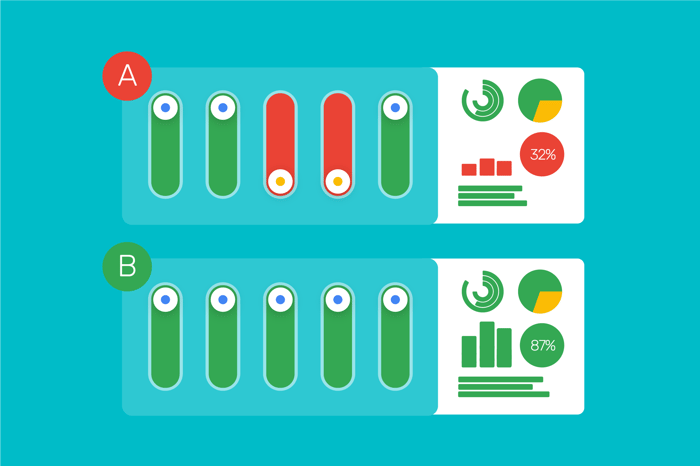Updated on July 12, 2023 | 4 minute read | Laura Burton
Home > Resources > The Google Smart Shopping ‘trap’ with A/B testing
What is A/B testing in marketing?
The risks of A/B testing your Smart Shopping campaigns
If Smart Shopping takes priority, what does it mean for retailers?
Google has retired Smart Shopping campaigns and has replaced them with Performance Max campaigns. Get up-to-date information on Performance Max here.
Launched in 2018, formally known as Universal Shopping Campaigns, Smart Shopping is a type of campaign that sits within Google Ads. It automates bidding on products that are optimized towards the advertiser’s target ROAS.
In digital marketing, A/B testing is a great way to get information on which types of campaigns work best and what you can do to optimize them.
A/B testing, also known as split testing, is the process of splitting your target audience in order to test different variations of a campaign, with the goal of determining which performs best.
Learn more about Google Shopping campaigns
So, for example, version A of a campaign will be shown to one control group, and version B will be shown to another. From there, you gain valuable insight into which iteration of a campaign performs better.
If you can see which version of a campaign works the best, you can increase your potential conversion rate. A/B testing is low in cost and high in reward, making it a staple testing method in the world of digital marketing.
Receiving results from A/B testing can take a varying amount of time depending on the type of campaign being tested. Common goals for this kind of testing include higher conversion rates, lower bounce rates, and increased website traffic.
Having a testing method that eliminates guesswork from website optimization and helps you make data-driven decisions can be hugely beneficial for advertisers.
Discover why your search term data is digital gold dust

Mid 2021, Google began offering a tool that enables retailers to A/B test their Shopping campaigns against Google Smart Shopping campaigns.
Naturally, as marketers, any opportunity to A/B test campaigns and strategies is already appealing, and Google Shopping reps often recommend giving part of the catalog to Smart Shopping to run in parallel.
Initially, it sounds like a great idea. However, there are some issues with the way the test works, and the validity of the results.
Firstly, Smart Shopping has access to all the data Google learns from users shopping via their search engine. This wealth of search term and performance data is used to inform their Smart Shopping campaigns.
Yet, advertisers using Smart Shopping will never be able to access their own search term data to use in their advertising and marketing activities beyond Google ads.

Since Google is effectively both the player (Smart Shopping) and the umpire (Google Shopping), the A/B test tool provides no independence between the two tests producing invalid results.
Finally, Smart Shopping will take priority over Standard Shopping campaigns. That's not an unfounded accusation of ours, they even state this in their help center!
“For the same products or groups of products, Smart Shopping campaigns take priority over standard Shopping and display remarketing campaigns for the same account.”
(source: Google)
Experts in Google Shopping can ascertain that Smart Shopping uses some form of intent structure, not unlike Bidnamic’s own automation. However, Bidnamic’s approach to Shopping campaigns and their search term data enables our clients to gain unlimited access to all their data.
How is Bidnamic different from Smart Shopping? Here's how
When you’re eligible to show for the same impression or click, it will be given to Smart Shopping, making A/B testing difficult. This then makes it hard to make decisions based on data, so you may be unsure of how best to optimize your campaigns.
To prevent this from happening you can select different segments of the product catalogue. However, we strongly suggest that you isolate products that don’t overlap with broader awareness search queries.
For example, if we place a footwear retailer on a Smart Shopping test, we wouldn’t be able to segment simply by brands like “Adidas” and “Nike”.
Terms such as “running shoe” or “men’s long-distance size 10 running shoe” would be eligible in both campaigns and, as such, Smart Shopping would take priority to serve this ad.
It’s never been easier to sell online, but it’s never been harder to beat the competition.
Read our article on when (and when not) to use Smart Shopping
Read our guide to Smart Shopping here, or check out more of our FAQs, resources and updates on Google Shopping here.

